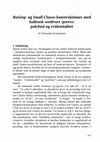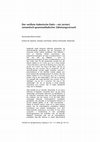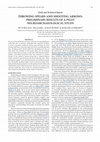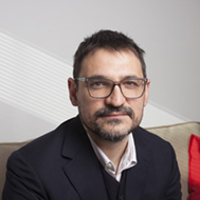Papers by Alexandra Kratschmer
Biocultural Theory: The Current State of Knowledge
Evolutionary Behavioral Sciences, 2015
ABSTRACT
La selezcione ausiliare dei verbi pronominali nei tempi perifrastici: un contrasto diacronico franco-italiano
Actas Do Xix Congreso Internacional De Linguistica E Filoloxia Romanicas Vol 5 1993 Isbn 84 87819 20 6 Pags 467 480, 1993

Arbejdspapirer, 2005
Denne artikel skal ses i forlaengelse af min artikel Italiensk sembra/pare + kompletivsaetning: m... more Denne artikel skal ses i forlaengelse af min artikel Italiensk sembra/pare + kompletivsaetning: modus og polyfoni . Mens den sidstnaevnte praesenterede en semantisk analyse af den italienske upersonlige konstruktion "sembra/pare + kompletivsaetning", kan jeg nu supplere disse resultater med mine nyeste resultater om raising-og small clause-konstruktioner på basis af sembrare/parere. Derudover vil jeg gerne belyse, hvordan de tre konstruktionsformer fungerer i konkrete tekster som en direkte følge af både deres semantiske og syntaktiske egenskaber. syg"). Jeg har tidligere argumenteret for, at den her involverede modus har en semantik, der kan parafraseres med "foreløbig konklusion": ved at bruge sembrare/parere formidler afsenderen at han/hun bedømmer et sagsforhold ud fra det i øjeblikket for ham/hende til rådighed stående informationsgrundlag, men at bedømmelsen muligvis kan/skal revideres senere. I

Tidsskrift for Sprogforskning, 2004
sera question dans les pages suivantes d'en dévoiler les mécanismes. Ces messages, adressés au pu... more sera question dans les pages suivantes d'en dévoiler les mécanismes. Ces messages, adressés au public d'une manière soit explicite soit habilement implicite et cachée, concernent non seulement des questions de philosophie et de théorie de l'histoire (v. nos points 1. à 4.), mais aussi, à un méta-niveau, le rôle social du même historien (v. notre point 5.). Nous allons montrer en plus, comment ces deux moments -l'attitude théorique de l'historien ainsi que son attitude quant à son propre rôle social -sont étroitement liés l'un à l'autre. Et ce sera à ces deux niveaux que Voltaire et Montesquieu, aussi frères d'armes qu'ils soient dans la cause des Lumières, se révéleront, à travers leurs textes, comme historiens, politiques et littéraires nettement distincts Alexandra Kratschmer, Voltaire et Montesquieu 70 Alexandra Kratschmer, Voltaire et Montesquieu 70 l'un de l'autre. À Montesquieu pragmatiste tempéré sinon pessimiste s'opposera ainsi Voltaire optimiste par principe, réformateur fervent et ainsi polémiste belligérant (v. 5.1.). Nous terminerons en perspectivant notre exposé par une proposition de cadre théorique concernant les conditions d'écrivain en général (v. 5.2.).

Tidsskrift for Sprogforskning, 2006
Angående nogle bestemte italienske epistemiske og deontisk/aletiske praedikater kan der konstater... more Angående nogle bestemte italienske epistemiske og deontisk/aletiske praedikater kan der konstateres en semantisk forskel mellem praedikater med tilføjelser i form af dativiske klitiske pronominer eller praepositionssyntagmer på basis af praepositionen a på den ene side og tilføjelser i form af praepositionssyntagmer på basis af praepositionen per på den anden side. På det epistemiske område kan der skelnes mellem fx mi è chiaro og a me è chiaro (ordret "mig er det klart"), som har en laesning (io) so "jeg ved", og per me è chiaro "for mig er det klart", der har en laesning (io) sono convinto "jeg er overbevist". På det deontisk/aletiske område ligger forskellen derimod i praesentationen af det dativiske modale subjekt som enten absolut eller paradigmatiseret via emfase. Der kan skelnes mellem fx mi è necessario og a me è necessaio (ordret "mig er det nødvendigt"), som har en laesning (io) [udeladt eller svagt betonet] sono costretto "jeg er nødsaget", og per me è necessario "for mig er det nødvendigt", der har en laesning io [med emfatisk intonation] sono costretto "der er nogen (deriblandt mig), som er nødsaget".
Les explications défectives en tant que moyens de manipulation rhètorique: analyse sémantique et pragmatique de certains énoncés de Bossuet et de Voltaire
Actas Del Xxiii Congreso Internacional De Linguistica Y Filologia Romanica Vol 2 Tomo 2 2003 Isbn 3 484 50396 3 Pags 3 12, 2003
Arbejdspapirer, 2006
Der vorliegende Artikel ist eine etwas umgestaltete deutsche Fassung von Kratschmer/Nølke 2005. E... more Der vorliegende Artikel ist eine etwas umgestaltete deutsche Fassung von Kratschmer/Nølke 2005. Einige der dort behandelten Punkte werden weniger ausführlich diskutiert, während der Abschnitt 3. zu den komplexen Vergangenheitskontexten sowie der Abschnitt 5. zur deutschen Terminologie neu hinzu gekommen sind.
Catégorisation vs comparaison : une question de quantification épistémique. Modèle interprétatif sémantico-pragmatique modulaire des constructions italiennes avec sembrare / parere
Marqueurs temporels et modaux en usage, 2000
Che te ne sembra? Semantica e pragmatica delle costruzioni italiane con sembrare/parere Kratschme... more Che te ne sembra? Semantica e pragmatica delle costruzioni italiane con sembrare/parere Kratschmer, Alexandra, Università di Aarhus Micro-pragmatique des langues romanes/Micro-pragmatica delle lingue romanze [riassunto: metteremo a disposizione un profilo d'uso per una serie di costruzioni basate su sembrare/parere. Questo profilo, di pertinenza sia teorica che pratico-didattica, tiene conto di fattori semantici come la modalità, l'evidenzialità e la polifonia, di fattori grammaticali e di fattori pragmatici come la dicotomia tema/rema, la focalizzazione e il livello stilistico.]
Jeg praesenterer i det følgende nogle foreløbige resultater fra et pilotprojekt, hvis målsaetning... more Jeg praesenterer i det følgende nogle foreløbige resultater fra et pilotprojekt, hvis målsaetning er at fastslå en bestemt gruppe upersonlige italienske udtryks polyfone mønstre. Det drejer sig i første omgang om konstruktionen sembra/pare + kompletivsaetning, men det skal senere udvides med en analyse af andre upersonlige konstruktioner, der -ligesom den lige naevnte -indeholder et modalt element i deres semantik. Jeg henviser til ScaPoLine (Nølke/Fløttum/Norén 2004) som teoretisk basis og undlader derfor at praesentere de her brugte beskrivelsesredskaber i alle detaljer.
158. Das Altkastilische in seinen Texten / El castellano medieval a través de sus textos. a) Marksteine des Altkastilischen/ Momentos constitutivos del castellano medieval
Die einzelnen romanischen Sprachen und Sprachgebiete vom Mittelalter bis zur Renaissance, 1995

The Evolution of Language, 2014
We present the preliminary outcomes of the first neuroarchaeological study that aims to generate ... more We present the preliminary outcomes of the first neuroarchaeological study that aims to generate comparable data regarding variation in levels of cognitive complexity during spear throwing vs arrow shooting with a bow. Stone Age weapon use can be traced through deep time. Studying aspects thereof might have implications for how we think about the evolution of the human brain and the thinking processes that make us human. A pilot EEG-ERP (electroencephalography, event-related potential) study was conducted to evaluate changes in the volume of neural energy that is required between simple, replicated spear-throwing and arrow-shooting tasks. When participants engaged in the experimental tasks, we recorded consistent, and statistically significant higher levels of activity in delta, theta, alpha and beta frequency bands across the parietal, frontal midline and orbitofrontal cortices of the human brain. Based on our sample size of only four individuals, these results are considered preliminary, but they indicate the potential for similar studies in the future.

Evolutionary Behavioral Sciences, 2017
Biocultural theory is an integrative research program designed to investigate the causal interact... more Biocultural theory is an integrative research program designed to investigate the causal interactions between biological adaptations and cultural constructions. From the bi-ocultural perspective, cultural processes are rooted in the biological necessities of the human life cycle: specifically human forms of birth, growth, survival, mating, parent-ing, and sociality. Conversely, from the biocultural perspective, human biological processes are constrained, organized, and developed by culture, which includes technology , culturally specific socioeconomic and political structures, religious and ideological beliefs, and artistic practices such as music, dance, painting, and storytelling. Establishing biocultural theory as a program that self-consciously encompasses the different particular forms of human evolutionary research could help scholars and scientists envision their own specialized areas of research as contributions to a coherent , collective research program. This article argues that a mature biocultural paradigm needs to be informed by at least 7 major research clusters: (a) gene-culture coevolution; (b) human life history theory; (c) evolutionary social psychology; (d) anthropological research on contemporary hunter-gatherers; (e) biocultural socioeconomic and political history; (f) evolutionary aesthetics; and (g) biocultural research in the humanities (religions, ideologies, the history of ideas, and the arts). This article explains the way these research clusters are integrated in biocultural theory, evaluates the level of development in each cluster, and locates current biocultural theory within the historical trajectory of the social sciences and the humanities.










Uploads
Papers by Alexandra Kratschmer